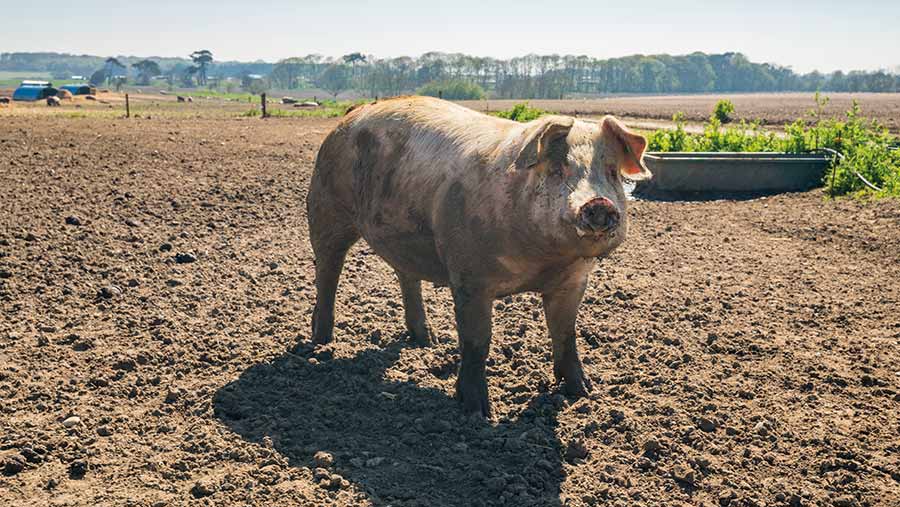Outlook 2023: New routes to market crucial for pig sector
 © Daniel/Adobe Stock
© Daniel/Adobe Stock Pig producers have experienced an incredibly challenging few years, as prices followed a different trend to other key agricultural commodity prices, while costs soared.
AHDB costings show producers have lost about £600m over the past two years, while the National Pig Association has suggested that 80% of pig farms could go out of business in the next 12 months if things do not change.
The sector has struggled with the knock-on effects of African swine fever elsewhere and, more recently, shortages of both carbon dioxide and skilled butchers in cutting plants.
See also: Pig feed and nutrition articles
In addition, there has been unprecedented ag inflation in key inputs since the Russia-Ukraine conflict began.
Feed has doubled in price, fuel is 75% more expensive, labour/contracting costs are up 20% and finance costs continue to rise.
Pig market summary
- Pig producers have lost about £600m over the past two years
- The effects of African swine fever, carbon dioxide shortages and rampant ag inflation have outweighed pigmeat price increases
- Could processors and producers co-operate more to find new routes to market?
- Could contracts be developed to allow producers to sell on margin rather than price?
Yet the average price that producers have received has only risen by an average of 32% since the start of the Covid-19 pandemic.
This compares with the average headline price increase for wheat (74%), or milk (65%) over the two-year period.
How did the industry get here, and what can it do to change?
Volatility has always been a factor for pig producers.
However, the frequency and range of volatility appear to be more significant than in other sectors, which makes running a viable and sustainable business almost impossible.
Feed is the number one cost for producers, now accounting for more than 70% of the cost of production.
Therefore, it would be expected that the pig price would more closely track the feed price than it does.
Over the past 20 years, the industry has seen the consolidation of pork supply chains, with processors now actively involved in production.
Despite their awareness of the production challenges, this has not led to an upturn in fortunes for producers.
Does this illustrate that processors, like farmers, are just pawns in the retailers’ game, asks Andersons consultant Harry Batt.
“As in chess, pawns are strong together, but weak when isolated. Together, the processors and producers control the supply chain so, through co-operation, could they find a new route to market?
“For example, Amazon British Pork – is this a realistic future vision? Change happens; look at the high street,” says Mr Batt.
“Alternatively, is the future about negotiating a contract to give a margin rather than the conventional price? Could most producers sell pork for a margin over the cost of feed? Would this drive improvements in feed efficiency?
“It would almost certainly reduce risk, while securing supply for the retailer.
“Given the current doom and gloom surrounding the pig industry, it would be easy to say that there might not be a commercial sector before long.
“However, the sector has experienced significant change over the past 50 years since Andersons was formed.
“Its consultants back then would have been discussing the expansion of UK pig production, which hit a high point of 9 million head in 1973.”
At the time of writing Outlook 2023, numbers had fallen to about 5 million, with further contraction likely. With the rise in sow productivity, the change in the size of the breeding herd has been even more marked.
Sow numbers in 1973 stood at about 780,000, now they are down to 340,000.
This seismic change can be partly attributed to a number of one-off incidents, not least the unilateral ban on sow stalls introduced in the UK in 1999 while the rest of the EU continued to use these systems.
This perhaps illustrates that the race to the bottom on price is the chronic issue killing the pig industry.
“However, we believe that producers have faced incredible challenges in the past and have remained resilient.
“There will be different challenges, with more focus on breeding/genetics, nutrition and resource/energy efficiency,” says Mr Batt.
“Producers need to set Smart [specific, measurable, achievable, relevant and timebound] targets for their individual system, focusing on reducing their carbon footprint, as this will intrinsically link back to feed, fertility and energy.
“The sector as a whole must be proactive in monitoring, improving and explaining the greenhouse gas emissions of British pork, alongside a clear commitment to animal welfare, both of which offer important marketing messages.
“We are at the point at which the sector must change if my successor is to have something to write about in 50 years’ time,” he says.
